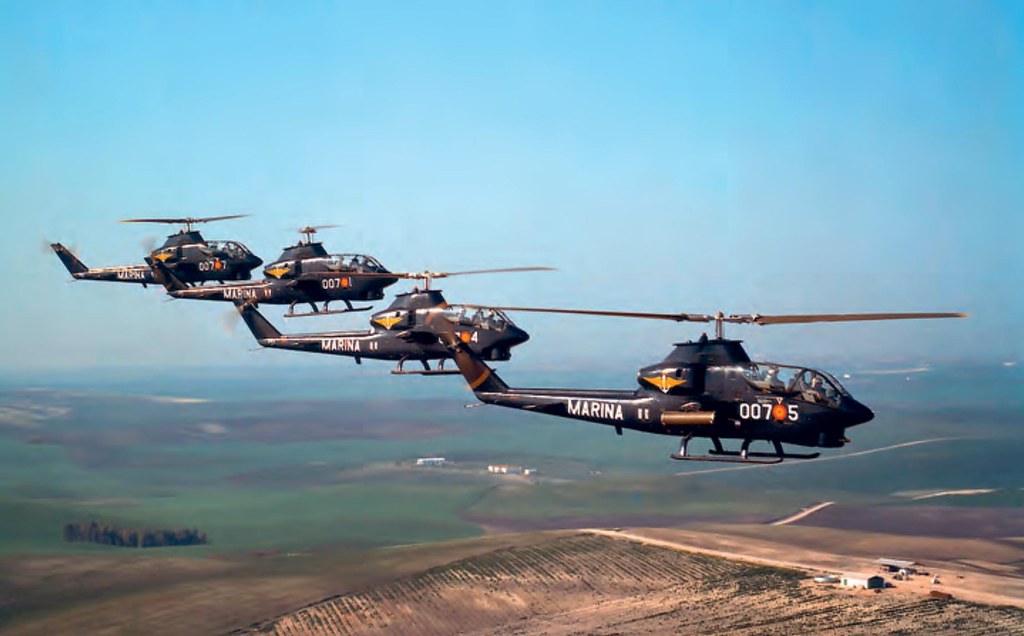The AH-1G attack helicopter of the Spanish Navy that ended up in a US museum
Between 1972 and 1987, the Spanish Navy operated eight Bell AH-1G Huey Cobra attack helicopters, part of the 7th Squadron.
Of these eight helicopters, the first four, which arrived in Spain in September 1972, were donated by the US, and the remaining four, which arrived in January 1973, were purchased by the Spanish Navy.

Two years ago we saw here the tragic story of those helicopters. Four of them were lost in accidents that left five crew members dead. One of these accidents occurred during a photo session in which four AH-1Gs were flying in formation near Chipiona (Cádiz) on February 22, 1974, when one of the Huey Cobras, 007-5 (Z.14-05), collided in flight with a Hughes 500 of the 6th Squadron (Z.13-04), both aircraft crashing to the ground and their four crew members dying. The photo you see on these lines is one of those taken by one of the deceased before the accident (photo: Spanish Navy).

One of the helicopters that appeared in that tragic photo was Z.14-01 (007-1, cn 21050). The second from the left appears in the formation. On these lines we can see it in a photo published by the Naval Forum in 2013, since the "Armada" sign instead of the initial "Marina" sign they originally wore, with the registration HA.14-1 and the numeral 01 -701 that it carried in his last years of service in Spain. According to Aerial Visuals, this helicopter was built in 1971 and it was registered by the US Army under serial number 71-15090, for accounting purposes only, since the helicopter had been manufactured for the purpose of delivery to Spain.

These helicopters were the close support aircraft of the Spanish Navy before the arrival of the AV-8S Harriers (called "Matador" in Spain) in 1976. Here we can see four AH-1Gs in the aircraft carrier "Daedalus" R-01 in its first years of service. The Z.14-01, protagonist of this story, is the second from the left. At that time, Navy aircraft still wore the St. Andrew's cross on the tail, as seen in the photo (one of the few images showing AH-1Gs with that insignia). It was eliminated shortly after due to a dispute with the Air Force (photo: Foro Naval).

At the end of May 1980, after the last accident involving the AH-1Gs, only four assets remained in the Spanish Navy: the Z.14-01, the Z.14-02, the Z. 14-04 and Z.14-08. Of these, only the last one was part of the second batch of helicopters that was bought by Spain. The Z.14-08 is preserved today in San Fernando (Cádiz). The 7th Squadron was deactivated in October 1984, although the remaining Spanish AH-1Gs continued to fly until March 1987, when the first three were returned to the US (photo: Foro Naval).

When the Z.14-01 returned to its country of origin, the AH-1Gs of the US Army had already been withdrawn from service, being displaced by the more modern AH-1S, which in turn it had already begun to be replaced by the AH-64 Apache. Thus, the Z.14-01 was repainted with the typical decoration of US Army helicopters, with the insignia of the 101st Airborne Division and its original serial number 71-15090 on the tail, thus losing the beautiful blue livery that it used in Spain. By then it was already a museum piece, so it was placed on the façade of the US Army Aviation Museum (which I already told you about here), in Fort Rucker, Alabama. This photo was taken of Glenn Chatfield on September 14, 2003.

Here we can see a picture of Rotorwash in which we see the Z.14-01 on the façade of the aforementioned museum. It was there for a long time and a large part of the photos that are preserved today of this helicopter are from his stay in that place.

In January 2014, after many years out in the open, Z.14-01 was removed from the façade of that museum. In its place was placed AH-1S 0-17109, which we already saw here. But that was not the end of the veteran of the Spanish Navy. It was taken to the museum's storerooms, where Alan Wilson took this photo of it in November 2013.

As we can see in this other photo by Alan Wilson, the Z.14-01 had very faded paint after so many years outside the museum. Would this be the end of our old sailor? Well no.

On February 9, 2021, Rotorwash posted on ARC Forums a series of photos of the restoration process of the Z.14-01 outside the Army Aviation Museum from USA.

In this other photo of Rotor Wash we see the beginning of the repainting process, with plastic under the skids of the helicopter.

Rotorwash also posted this photo of the tail of the Z.14-01, with the 101st Airborne Division insignia worn on the tail on the starboard side. This insignia spent many years facing the facade of the aforementioned museum, without anyone being able to see it.

Finally, Rotorwash also published this photo in which we see the Z.14-01 already restored and inside the museum. Unfortunately, and as indicated by the museum's website, the Z.14-01 is not yet on public display, so it will still be in the museum's warehouses. Hopefully one day they can expose it and so we have the opportunity to see a former member of the Spanish Navy sharing space with veterans of the US Army.
---
Main photo: Foro Naval.
|
Don't miss the news and content that interest you. Receive the free daily newsletter in your email: |
- Most read
- The 'hole' without civil flights around Paris during the opening of the Olympic Games
- Stunning footage of the F-15QA Ababil in flight recorded from its cockpit
- The firearms used by the Pontifical Swiss Guard, the smallest army in the world
- Eurofighter vs F-35: the opinions of professional pilots on these advanced fighters
- The first photo of an F-16 fighter with Ukrainian insignia and the details it has revealed
- The most distant deployment of the Spanish Air Force in Australia and New Zealand
- This is the driver station of an M1 Abrams tank and the impressive start of its engine

 ES
ES







Opina sobre esta entrada: